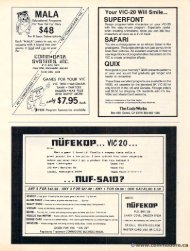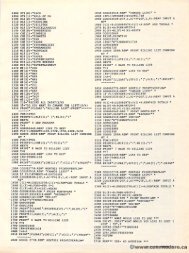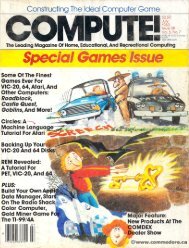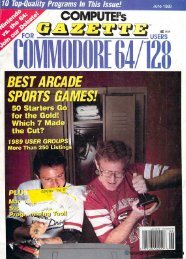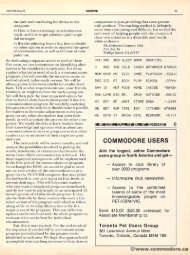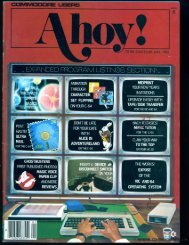May June 1980 - Commodore Computers
May June 1980 - Commodore Computers
May June 1980 - Commodore Computers
Create successful ePaper yourself
Turn your PDF publications into a flip-book with our unique Google optimized e-Paper software.
MAY/JUNE, I JUNE. <strong>1980</strong>. 198O. ISSUE 4. COMPUTE. "5 115<br />
Relocate PET Monitor<br />
Almost Anywhere<br />
The Monitor program provided on tape to owners<br />
of PETs with the old ROMs occupies locations (in<br />
hex) $0400 to 5076B, S076B, right where the PET stores<br />
BASIC programs' programs! If you're only interested in working<br />
with 6502 machine language routines, that location<br />
for the Monitor poses no problem. .<br />
Unfortunately for me, I wanted to have the<br />
Monitor available at the same time as BASIC programs.<br />
Despite a variety of attempts, I was unable<br />
to find a combination that would allow me to enter<br />
and run BASIC programs while having the Monitor<br />
available in its original location.<br />
On the other hand, if the Monitor could be<br />
moved somewhere very near the highest available<br />
memory location with which the PET is equipped,<br />
then the end-of-memory pointer could be reset to<br />
protect the Monitor. Then a BASIC program could<br />
be run, and it would not interfere with the<br />
Monitor.<br />
Myy problem appeared to be solved when I found<br />
an article by Professor Harvey B. Herman of the<br />
University of North Carolina ("Move It", MICRO,<br />
September 1979). . Although a critical figure seemed<br />
to be missing from the article, it was not too difficult<br />
to puzzle out, since the technique was based on<br />
an article by Jim Butterfield in the PET User Notes<br />
(Issue I, 1, Vol. 2). Incidentally, Jim has been a key<br />
figure in unravelling the secrets of the PET, both<br />
publishing information himself and pointing others in<br />
the right direction. .<br />
Although a relocation technique is summarized<br />
in this article, the discovery that got me excited<br />
was a simple e but powerful extension to make ii it do<br />
many relocations, after the first one was completed.<br />
Why would anyone want to relocate the MonitorM to many different locations? The answer lies in the<br />
earlier observation that it would be desirable to<br />
locate it near the top end of available memory.<br />
With a 4k PET, a good location for the MonitorM would be starting at the 3k location. On an 8k PET,<br />
you would want to locate it from 7k up. If a 4k PET<br />
had ana n 8k memory extension attached, giving a total<br />
of 12k, the Monitor should be located at the Ilk<br />
point. Other combinations of PETs and external<br />
memories would lead us to want Monitors located<br />
ata t 15k, 19k, 23k, 27k and 31k.<br />
.<br />
With the approach described here, all of those<br />
Monitors can be created in little more time than it<br />
takes to SAVE each one.<br />
First, we must create one working Monitor<br />
relocated to a position where it does not conflict<br />
with the e original. Here's one way to do it:<br />
1. I. LOAD the e Monitor (Prim (Print STATUS; PEEK<br />
(630) to insure that the LOAD was good ...<br />
Roy Busdiec ker<br />
Roy Busdiecker<br />
Micro Software Systems<br />
PO P.O. Box 1442<br />
Woodbridge, VA 22193<br />
PET should print 0 0). Rewind the tape.<br />
2. Type SYS62894, then press RETURN. You<br />
will get the message PRESS PLAY ON<br />
CASSETTE #1. Insert the Monitor tape<br />
tape and press PLAY. The tape will run<br />
until the FOUND MONITOR message<br />
appears, then it will report READY. At<br />
this point the tape header has been found<br />
and loaded into locations 634 through 638,<br />
but the Monitor itself has not started loading.<br />
Here is the meaning of bytes 635<br />
through 638.<br />
635<br />
636 637 638<br />
10 lo byte<br />
First location that<br />
program tape will<br />
load into.<br />
hi byte 10 lo byte Last location that<br />
program tape will<br />
load into.<br />
hi byte<br />
3. By changing the values in these locations, we<br />
can make this second copy load into a<br />
different area of memory. For this exercise,<br />
let's put it into locations 3k (decimal 3072,<br />
hex OCOO) 0C00) and up. To do that,<br />
POKE 636, 12:POKE 638,15:SYS 62403<br />
The tape will run and PET will report<br />
LOADING until the MonitorM is in. . Rewind<br />
the tape and set it aside. At this point,<br />
you will have two identical copies of the<br />
Monitor. M One is located from $04000 to<br />
S076A ($ (S indicates a hex value), as shown<br />
in Figure 1. The other copy is in locations<br />
S0COO SOCOO to $0C6A SOC6A (see Figure 2 for the first<br />
128 locations). The second copy, of course,<br />
will not work because its addresses point to<br />
the wrong locations.<br />
4. In order to make the $0C00-0C6A $OCOO-OC6A copy<br />
of the Monitor usable, you must alter<br />
(patch) the contents of 84 memory locations.<br />
There area several ways to do this, but the<br />
straight-forward approach I used (outlined<br />
below) is about as easy as any other.<br />
a. TypeT SYS 1039 and a press RETURN.<br />
This transfers control to the $0400- S0400-<br />
$076B Monitor, M which will display<br />
PC SR AC XY YR SP<br />
C6ED 30 33 39 00 FE<br />
b. b . Consult Figure 1I to see which values<br />
are to be changed (the circled numbers).<br />
A circled value in line 0410 calls for a<br />
change in the corresponding position in<br />
line 0C10. OC Line 0500 corresponds to<br />
OD 10, 0600 to OEOO , and 0700 to<br />
0D10, 0600 to 0E00, and 0700 to



